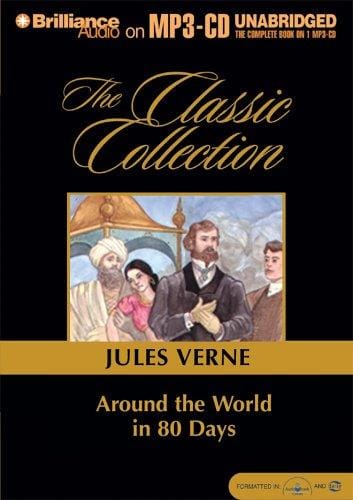Around the World in 80 Days: A Timeless Globe-Trotting Adventure
Explore the plot, themes, characters, and cultural impact of Jules Verne’s classic adventure novel Around the World in 80 Days.

Introduction
More than 150 years after its publication, Jules Verne’s "Around the World in 80 Days" continues to fire the imaginations of readers, travelers, and filmmakers alike. The novel chronicles the seemingly impossible wager of Phileas Fogg, an English gentleman who bets his fortune that he can circumnavigate the planet in just eighty days. Part travelogue, part suspense thriller, and part celebration of human ingenuity, the story remains a cornerstone of classic literature and a yardstick by which epic journeys are measured. In this article, we explore the plot, characters, thematic depth, historical context, modern relevance, and enduring legacy of Verne’s masterwork.
Plot Summary
The action begins in 1872 London, where the methodical and mysterious Phileas Fogg lives by the strict ticking of his pocket watch. After a spirited discussion at the Reform Club regarding the latest advances in global transportation, Fogg stakes a £20,000 wager that he can travel around the world in eighty days. Accompanied by his new valet, the lively Frenchman Jean Passepartout, Fogg departs that very evening by train and steamship. Their whirlwind itinerary races from Suez to Bombay, across India’s interior to Calcutta, onward to Hong Kong, Yokohama, San Francisco, New York, and finally back to London.
Complications are plentiful. Detective Fix from Scotland Yard shadows the travellers, convinced that Fogg is a bank robber. Natural disasters, schedule mishaps, and cultural obstacles threaten to derail the clock-obsessed gentleman at every leg. Among the most memorable detours is the daring rescue of Aouda, a young Parsee woman about to be forced into sati. By the time the party reaches Liverpool, a mere delay of hours appears to doom the wager—until Fogg realizes that crossing the International Date Line has gained him an extra day. He arrives at the Reform Club with seconds to spare, winning both the bet and Aouda’s hand in marriage.
Main Characters
Phileas Fogg: Stoic, punctilious, and enigmatic, Fogg personifies the Victorian faith in rational planning and technological progress. His outward detachment masks a genuinely heroic heart.
Jean Passepartout: The warm-blooded foil to Fogg’s cool logic, Passepartout provides comic relief and emotional resonance. His adaptability and loyalty often save the journey.
Aouda: Rescued from an unwanted fate, Aouda evolves from damsel in distress to a decisive companion whose affection humanizes Fogg.
Detective Fix: Driven by duty, Fix is both antagonist and inadvertent ally. His dogged surveillance underscores themes of misjudgment and cultural misunderstanding.
Key Themes and Motifs
The Triumph of Technology: Verne wrote at a time when railways, steamships, and the telegraph were shrinking the globe. The novel celebrates these marvels while showcasing the limits of human planning in the face of chance.
Time as an Antagonist: The ticking clock intensifies suspense, turning every delay into a crisis and every stroke of good luck into a lifeline. Fogg’s obsession with punctuality underlines the industrial era’s new relationship with time.
Cultural Exchange and Eurocentrism: The whirlwind tour introduces exotic locales through European eyes, reflecting both the curiosity and biases of the age. Modern readers may critique colonial undertones but can also appreciate Verne’s relatively progressive fascination with other cultures.
Character Duality: Fogg and Passepartout embody logic versus spontaneity, illustrating that successful exploration requires both meticulous planning and improvisational spirit.
Historical Context and Technological Optimism
Published in 1873, the novel captures a pivotal moment when newly laid transcontinental railways and expanded steamship routes made global circumnavigation feasible for the first time. The Suez Canal had just cut sailing times between Europe and Asia, and the American Transcontinental Railroad linked the Atlantic and Pacific coasts. Verne’s meticulous research lent credibility to Fogg’s schedule, feeding public fascination with geography and industrial wonders. The story mirrored the Victorian belief that science and engineering could conquer distance, bolster commerce, and foster international understanding.
Modern Relevance and Travel Inspiration
Today, commercial aviation allows us to circuit the globe in under 48 hours, yet "Around the World in 80 Days" retains its allure because it champions the journey over the destination. Digital nomads, gap-year students, and adventure vloggers cite the novel as a spark for setting off on their own grand tours. Eco-conscious travelers have even attempted to replicate Fogg’s route using only low-carbon transport, proving that the book can inspire sustainable exploration. In an era of instant connectivity, Verne’s tale reminds us to savor the surprises, friendships, and cultural awakenings born from physical travel.
Adaptations Across Media
The novel’s cinematic sweep has invited countless adaptations. Michael Todd’s 1956 film, starring David Niven and Cantinflas, won five Academy Awards and introduced cameo appearances as a marketing sensation. The 1989 television miniseries added historical figures like Thomas Edison, while Disney’s 2004 version injected martial-arts flair with Jackie Chan. Radio plays, graphic novels, board games, and even virtual reality experiences continue to reinterpret the story. Each adaptation reflects its era’s technology and taste, yet the central race against time remains irresistibly gripping.
Final Thoughts
"Around the World in 80 Days" endures because it marries meticulous scientific speculation with unbridled imagination, proving that the most thrilling frontiers often lie within our resolve to push boundaries. Whether you approach the book as a literary classic, a blueprint for bucket-list travel, or a study in Victorian culture, its pages still pulsate with wonder. Like the best adventures, Verne’s masterpiece invites every reader to start the clock, pack lightly, and believe that the world is both smaller and richer than they ever dreamed.



